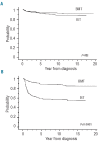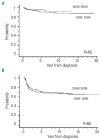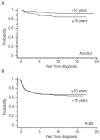First-line treatment for severe aplastic anemia in children: bone marrow transplantation from a matched family donor versus immunosuppressive therapy
- PMID: 25193958
- PMCID: PMC4258757
- DOI: 10.3324/haematol.2014.109355
First-line treatment for severe aplastic anemia in children: bone marrow transplantation from a matched family donor versus immunosuppressive therapy
Abstract
The current treatment approach for severe aplastic anemia in children is based on studies performed in the 1980s, and updated evidence is required. We retrospectively compared the outcomes of children with acquired severe aplastic anemia who received immunosuppressive therapy within prospective trials conducted by the Japanese Childhood Aplastic Anemia Study Group or who underwent bone marrow transplantation from an HLA-matched family donor registered in the Japanese Society for Hematopoietic Cell Transplantation Registry. Between 1992 and 2009, 599 children (younger than 17 years) with severe aplastic anemia received a bone marrow transplant from an HLA-matched family donor (n=213) or immunosuppressive therapy (n=386) as first-line treatment. While the overall survival did not differ between patients treated with immunosuppressive therapy or bone marrow transplantation [88% (95% confidence interval: 86-90) versus 92% (90-94)], failure-free survival was significantly inferior in patients receiving immunosuppressive therapy than in those undergoing bone marrow transplantation [56% (54-59) versus 87% (85-90); P<0.0001]. There was no significant improvement in outcomes over the two time periods (1992-1999 versus 2000-2009). In multivariate analysis, age <10 years was identified as a favorable factor for overall survival (P=0.007), and choice of first-line immunosuppressive therapy was the only unfavorable factor for failure-free survival (P<0.0001). These support the current algorithm for treatment decisions, which recommends bone marrow transplantation when an HLA-matched family donor is available in pediatric severe aplastic anemia.
Copyright© Ferrata Storti Foundation.
Figures



References
-
- Kojima S, Horibe K, Inaba J, Yoshimi A, Takahashi Y, Kudo K, et al. Long-term outcome of acquired aplastic anaemia in children: comparison between immunosuppressive therapy and bone marrow transplantation. Br J Haematol. 2000;111(1):321–8. - PubMed
-
- Mathe G, Amiel JL, Schwarzenberg L, Choay J, Trolard P, Schneider M, et al. Bone marrow graft in man after conditioning by antilymphocytic serum. Transplant Proc. 1971;3(1):325–32. - PubMed
-
- Young NS. Acquired aplastic anemia. JAMA. 1999;282(3):271–8. - PubMed
-
- Bacigalupo A, Brand R, Oneto R, Bruno B, Socie G, Passweg J, et al. Treatment of acquired severe aplastic anemia: bone marrow transplantation compared with immunosuppressive therapy--The European Group for Blood and Marrow Transplantation experience. Semin Hematol. 2000;37(1):69–80. - PubMed
-
- Doney K, Leisenring W, Storb R, Appelbaum FR. Primary treatment of acquired aplastic anemia: outcomes with bone marrow transplantation and immunosuppressive therapy. Seattle Bone Marrow Transplant Team. Ann Intern Med. 1997;126(2):107–15. - PubMed
Publication types
MeSH terms
Substances
LinkOut - more resources
Full Text Sources
Other Literature Sources
Medical
Research Materials

